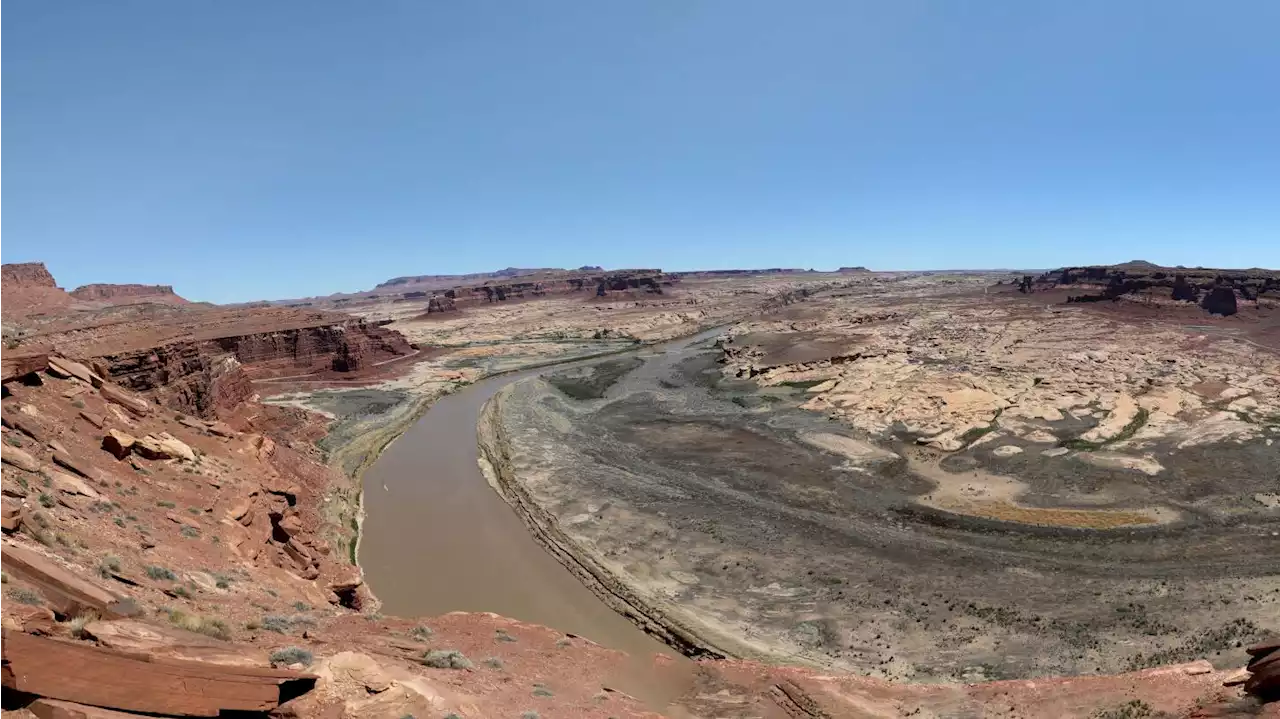For Star subscribers: As bad as conditions are today, they could get worse as hotter, drier conditions in the west intensify.
Tony graduated from Northwestern University and started at the Star in 1997. He has mostly covered environmental stories since 2005, focusing on water supplies, climate change, the Rosemont Mine and the endangered jaguar.
And while it's not clear if the river basin will get more or less rain and snow over the coming decades than is falling now, even the extra precipitation won't be enough to counteract the impacts of continued warming weather. The seven Colorado River Basin states, including Arizona, are now enmeshed in tense negotiations to try to meet a U.S. Bureau of Reclamation directive to cut their take from the river by up to 28% by next year. Cuts of that scale likely will be enough to stabilize the reservoirs at or near their current elevations, if river flows stay at currently depressed levels, says a seventh recent study, this one from Utah State University's Center for Colorado Studies.
Since 2000, the river has averaged about 12.1 million acre-feet a year of flows at the federal gauging station at Lee's Ferry, just downstream of Glen Canyon Dam. That compares to a 20th century average annual flow of about 15 million acre-feet. "In my mind a permanent 9.4 million acre-foot flow is not going to happen for awhile, but what do I know? In the near term, you could easily see 9.4 million acre-feet for an extended period of time, a five- to seven-year period.Wheeler acknowledged that conditions could certainly become worse than those assumed by researchers on the paper he worked, if already warming temperatures keep increasing.
Using a form of artificial intelligence to analyze climate data, the study predicts spring snowmelt will disappear entirely in some sub-watersheds in the Upper Basin. Large snowpack losses will occur in others, particularly in higher elevation areas such as the Rocky Mountains, the study found. The study examined results of six computer models that estimated Colorado River Basin temperatures will rise by a range of 7.3 to 12.6 degrees Fahrenheit by the period 2079 to 2099, compared to 1970 to 1999. Of those six models, three showed increases in precipitation and three showed decreases.
"As water cycles move through the system, if you have drier soils and increased evapotranspiration, that water, even if it’s falling in the form of precipitation, it simply runs off the landscape," Bennett said."It falls in the summer as opposed to arriving in the system in winter as snowpack that can be released as snowmelt and is able to be absorbed into the groundwater system.
The most dramatic finding came from a study that examined 2,000 years of Upper Basin tree ring records and other data. It found the lowest flows in that period came during the 2nd century, from 130 to 150. Besides tree ring data, the researchers used lake and cave sediments and sediments from bogs. But from 129 to 150, the river only carried 68% of the 1906-2021 flows, or 10 million acre-feet a year, the study found.
The other authors work for UA, the U.S. Bureau of Reclamation, the U.S. Geological Survey and Northern Arizona University. The study was published in June in the journal Geophysical Research Letters. Looking back to look ahead A study published in September by Utah State researchers took a similar tack, looking at tree-ring records of river flows over the past 600 years. The researchers then went a step farther, using those records to make future, drier flow projections.
The study looked specifically at three dry periods, ranging from 19 to 25 years long, dating from the 15th to the 20th centuries. The researchers used climate computer models to project future river flows, based on records randomly selected from each drought period. They created 100 sets of low-flow scenarios for the river based on individual droughts. The scenarios are"extreme but plausible," Tarboton said.
It warned that just considering rising temperatures' impacts, river flows could drop 14% to 31% from 2036 through 2065 from an annual average flow of 14.8 million acre-feet from 1913 through 2017. But he said he would strongly recommend that public officials and water managers consider the possibility of annual flows as low as 9 million within the next 30 years.
That study used computer models to project the river's annual average flow from 2023 through 2060 will be 12.39 million acre-feet. That's very slightly more than the river's average flow since 2000,while still representing a significant decline from the historic flow of 14.76 million acre-feet, from 1906 through 2019.
Plus, he pointed to the study's finding of a 10% chance that the annual river flow could average as little as 7.4 million acre-feet throughout the study period — less than half the river's historic average flow of the 20th century.
United States Latest News, United States Headlines
Similar News:You can also read news stories similar to this one that we have collected from other news sources.
 Former Magnolia West star John Matocha leads Colorado School of Mines into title gameHe is enjoying a sensational year in leading the Colorado School of Mines to the NCAA...
Former Magnolia West star John Matocha leads Colorado School of Mines into title gameHe is enjoying a sensational year in leading the Colorado School of Mines to the NCAA...
Read more »
 Man beaten by Colorado Springs police during traffic stop calls for criminal investigation into officers’ conductNEW: Attorneys for a man violently arrested by three Colorado Springs police officers in October are calling for a criminal investigation into the cops’ use of force. Watch the body camera footage now.
Man beaten by Colorado Springs police during traffic stop calls for criminal investigation into officers’ conductNEW: Attorneys for a man violently arrested by three Colorado Springs police officers in October are calling for a criminal investigation into the cops’ use of force. Watch the body camera footage now.
Read more »
 Get Outside: Ten Outdoor Brands From Colorado to Support This HolidayNeed a gift for a hiker, runner, cyclist, or skiier? Look no further.
Get Outside: Ten Outdoor Brands From Colorado to Support This HolidayNeed a gift for a hiker, runner, cyclist, or skiier? Look no further.
Read more »
 Club Q survivors blame 'hateful rhetoric' for Colorado Springs shooting'Hate speech turns into hate action, and actions based on hate almost took my life from me at 25 years old,' Michael Anderson, who was bartending at Club Q the night of the shooting that left 5 people dead and 17 others injured, told members of Congress.
Club Q survivors blame 'hateful rhetoric' for Colorado Springs shooting'Hate speech turns into hate action, and actions based on hate almost took my life from me at 25 years old,' Michael Anderson, who was bartending at Club Q the night of the shooting that left 5 people dead and 17 others injured, told members of Congress.
Read more »
 Survivors of Club Q shooting in Colorado Springs ask Congress for action against hate, violence“Powerful figures have insisted that the greatest threats this country faces are a teacher with they/them pronouns or someone in a wig reading Red Fish, Blue Fish,” a survivor of the 2016 Pulse nightclub shooting in Orlando said.
Survivors of Club Q shooting in Colorado Springs ask Congress for action against hate, violence“Powerful figures have insisted that the greatest threats this country faces are a teacher with they/them pronouns or someone in a wig reading Red Fish, Blue Fish,” a survivor of the 2016 Pulse nightclub shooting in Orlando said.
Read more »
Colorado Police Crack Down On Street Racing, Seize Chevy Camaro | CarscoopsWheat Ridge Police used a recently passed ordinance to seize a muscle car after it was involved in a street racing event
Read more »
